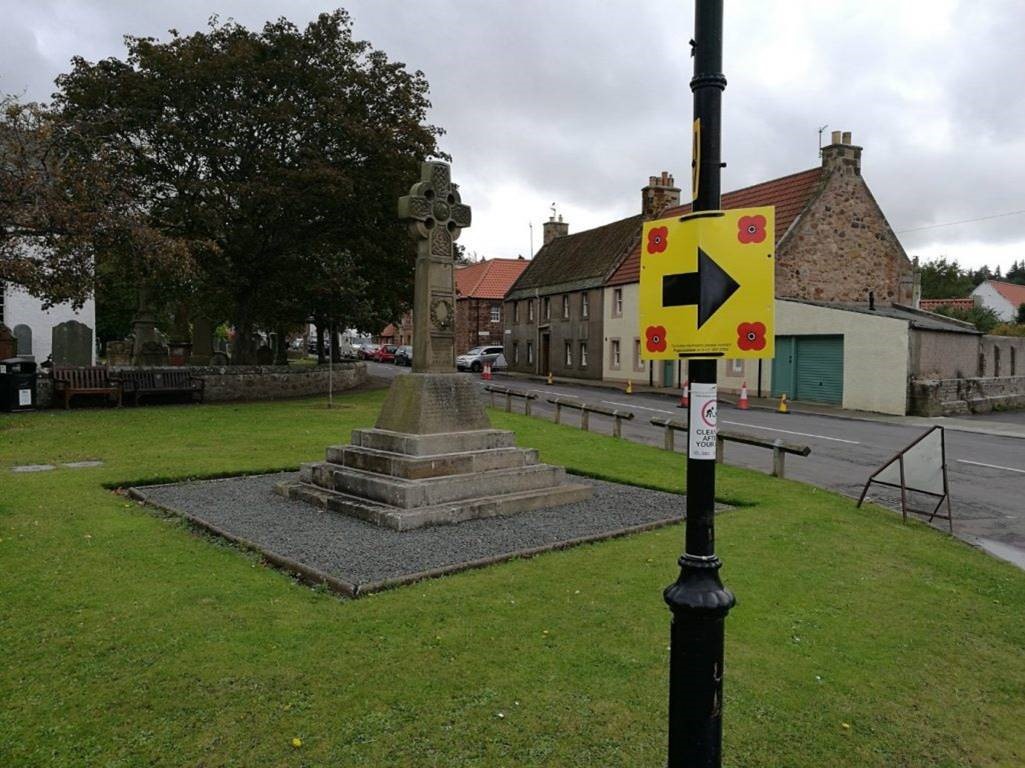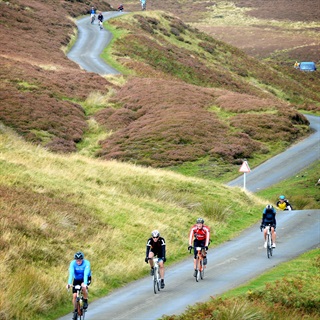Poppyscotland Sportive FAQ’s
For those of you who are new to cycling, who may be tackling your first or second Sportive – or those haven’t done one for a long time – here are some commonly asked questions that we receive to assist you.
Some tricks that make riding a bit easier, whatever your level, as well as ideas and suggestions to make sure you are well prepared on the day.
Some of these FAQs are taken from this general sportive advice in Cycling Weekly and some from experience gained from previous years events.
Rider notes
The rider notes can be read here: Rider Notes 2023
Where can I download the 2024 medical form?
For insurance purposes it's obligatory that all riders complete our 2023 Sportive medical form. Download the form here: Sportive Medical Form 2024
If all the places are sold out, is there a waiting list?
Yes, we will operate a waiting list, just drop us a line with your details.
Call us on 0131 557 2782 or Email events@poppyscotland.org.uk
Can I take part on an e-bike?
Yes! Riders on e-bikes are welcome to take part. Please note the following:
- There will be NO charging facilities on site. All e-bikes must arrive fully charged.
- They are only allowed to ride the short route.
- e-bike cyclists will be excluded from the timed hill climb.
- All cyclists will receive a time chip. Those using an e-bike will be highlighted on the results sheet.
Is there a minimum age requirement to enter the event?
No riders under 16 years old on the day of the event permitted.
When should I be eating?
Should I bring my own food with me?
Please do not depend on the food from the feeding stations alone.
Sportive participants need to bring their primary source of fuel with them - enough food to keep you going for the day.
We provide healthy snacks and water at the feed stations, e.g. banana, flapjack, crisps, dried fruit and nuts. High energy quality food to help get round the course.
We do not provide meals or large amounts of food and we advise you bring all the food you think you will need.
What is blowing up and how can I avoid it?
Blowing up is when your body runs out of energy during a bike ride – a bit like hitting the wall during a marathon - you feel absolutely terrible, as if you simply cannot go on.
Blowing up during a sportive is usually due to two main reasons: not fuelling properly or poor pacing strategy. Basically you need to ensure you ride within yourself enough to make it through the entire event, as going too hard too early or going too far into the red over a big climb can cause you to blow up.
Again – you need to be eating carbohydrate regularly for energy, and eating a little bit, possibly half a bar or a small piece of flapjack every half hour is a good rule of thumb to follow.
If you regularly forget to eat in rides or don’t eat enough, set an alarm on your watch for every 20 or 30 minutes and aim to eat something each time and drain your 500ml bottle every hour. This can also help to break down the ride into different sections to help keep your focus and help with your pacing.
Which Poppy Sportive route should I choose?
The Poppyscotland Sportive takes place in East Lothian and the Scottish Borders and the routes all involve hills! The medium and long route are especially challenging with longer distances that involve long climbs up into the Lammermuirs and over the infamous ‘Rigg’.
The elevation gain and loss statistics, also in graph form, for all 3 routes can be found in the route section.
We advise all participants familiarise themselves with the route they have chosen and are prepared for the climbs they will encounter.
Am I fit enough?
We strongly recommend that first time riders do some training runs of equal distance that include climbing so they are prepared on the event day itself.
You are likely to be fit enough to get round but you may have to moderate your expectations. There’s no point expecting a super-fast time on a 100-mile hilly route if you’ve only ever done 50-mile events before – but you may well be able to finish.
Be realistic; with the correct nutrition and pacing you should be able to get round most distances, but it’ll be hard and will take a lot longer. If you have ridden two thirds of your goal distance in training and a speed close to your target you should be fine on the day. It will be tough but the atmosphere and the presence of other riders to help with the work will keep you going – as long as you stick with your pacing and nutrition.What kit do I need?
We recommend you bring:
- Spare inner tubes, tyre levers and puncture repair kit
- Pump
- Multi tool
- Two full water bottles and some snacks
- Fully charged mobile
- Warm and waterproof layers
- Vaseline
- A little bit of money
Please check the weather forecast the night before and prepare accordingly! We will be sending weather updates out to all riders before the event so you should have an idea of what to expect.
General advice from cycling weekly:
- Taking a shell jacket or gilet is advisable as having to stop for mechanicals or descending can chill you very rapidly.
- On hot days, shorts and jersey with a thin undervest is plenty, adapting this with a thicker base-layer, gilet, arm and knee warmers is enough for cooler days and gives options for removing garments when it heats up. During much colder rides layers are needed, as well as thermal long tights and windproof thermal jackets
- The key is layers, keep an eye on the weather forecast in advance but take a judgement call on the morning and remember that if you need to take the layers off they’ll either need to fit in a pocket or risk being abandoned
- Newspaper down the front of your jersey or a plastic bag is perfect for early starts where the temperature will definitely rise as once you start to heat up they can be responsibly discarded.
What is the best size of group to ride in?
If you are not used to riding in a larger group, e.g. 4 or more riders, then don’t make this event the first time you try this out.
Take time to practice and get used to riding with others before you do this at a cycling event.
If you are not sure, then riding solo or with maybe one or two others is advisable, and equally enjoyable.
See this British cycling video on ‘how to Ride in a group’
What do the signs look like?
They look like this – bright yellow, with poppies in the corners.

What do the signs people in front of me keep doing actually mean?
A downward point warns of a pothole or something that you will want to avoid.
When a rider in front sweeps their left arm across their back, from left to right, it means you need to move out to go round a park vehicle or obstacle, if it’s done with the other arm, right to left, it’s to keep in to the left as there’s something coming.
Repeated patting of the air, by their bottom, indicates slowing down.
If riding in a group listen for shouts of potential hazards ahead from other riders.
See this British cycling video on ‘how to communicate with signals in a bunch’
When should I change gear while climbing?
When climbing, changing gear under pressure puts more strain on the chain – ease the pressure off as you shift to prevent it jumping. Anticipate the need to change gear by looking ahead and change into a lower gear before it becomes too steep, so the chain is not under too much pressure.
However, don’t change gear too early as you will end up spinning and prevent you from putting any power down.
Do I need to bring a map?
All three Sportive routes are fully signposted, but we strongly advise all participants bring or download their own route map.
You should take time to study the route you have chosen to ride before the event.
How do I avoid saddle sores or chafing?
How can I corner better?
Improving your cornering confidence is an easy way to get improve without having to boost your fitness. The key to cornering is taking the correct line: wide then sweeping in to hit the apex and then exiting wide again.
However, do remember – the Sportive is open road so don’t take silly risks to hit the right line. Keep the inside pedal up, put your weight through your outside leg to keep grip, and do your breaking before the corner not during it.
How do I pace myself?
Using feedback from heart rate or power is a good method of judging pace, knowing how different zones ‘feel’ is important. This is something that you need to learn and practice on your training rides.
There’s no harm in occasionally misjudging it or even deliberately pushing yourself harder than comfortable to see how long you can last – do it in training and there is nothing lost but you’ve gained knowledge on how to pace yourself.
You don’t necessarily need loads of high-tech tools, just monitoring your breathing and effort level is enough. If you’re aiming for a time, your riding pace needs to feel hard but manageable, breathing should be deep but if you can’t talk in complete sentences you are going too hard. You may be able to sprinkle a few harder efforts in to make it up the hills but ensure you don’t go into the red zone where your legs start to burn and your breath becomes gasping.
If you just want to ‘get round’ obviously you can take it at a much more leisurely pace but remember the payoff is you’ll be out longer which brings its own problems with fuelling and fatigue. Even at a ‘get you round pace’ you should still be aware that you are breathing at a deeper than normal rate.
How long do I have to complete the course?
Our sweep convoy will follow cyclists along all 3 routes route at a fixed speed of 10 mph for the short and medium and 13 mph for the long
- Short route: 5 hours to complete finished 14:00 at latest
- Medium route: 7.5 hours to complete finished 16:30 at latest
- Long route: 8.5 hours to complete finished 17:30 at latest
This includes 30 mins built in for stops.
Once the last wave of cyclists has left the start, our sweep convoy will follow cyclists along all 3 routes route at a fixed speed of 10 mph for the short and medium and 13 mph for the long.
Cyclists who fail to maintain this minimum average speed and are therefore overtaken by the sweep car are out of the ride. In this instance, cyclists will be asked to submit their timing chip to the sweep staff before continuing. This acts as an acknowledgement that they are no longer part of the event, and that the event infrastructure such as medical support and feed stations will no longer be available to them.
How can I be safer on descents?
Keeping it smooth is key when descending. Slamming brakes on and then pedalling furiously is inefficient, slower and also dangerous.
Getting on the drops lowers your centre of gravity, giving more control and makes it easier to cover your brakes. As you’re faster when descending leave a bigger gap between you and the rider in front and look further ahead than usual as potholes and other obstacles come up quicker.
Should I bother to warm up?
This depends on the distance you’re riding and what your aims are. For example, if you just want to pootle round and have a bit of a social on the 102-mile Poppy sportive, a warm up is probably not vital, whereas if you wish to smash the shorter 48-miler you may want to prepare yourself mentally and physically for the event. Warm ups are often important for fast starts or if the route hits a steep hill immediately.
They can vary from rolling up and down the road to a full blown, progressive effort with some sprints on the rollers. If you are going for a quick time a warm up can be beneficial as the front groups often start very fast and if you can stick in there – without burning yourself up for the rest of the event – it can help get you the finish time you want.






.jpg?sfvrsn=745ef67b_0&Width=320&Height=320&Method=CropCropArguments&ScaleUp=true&Quality=High)